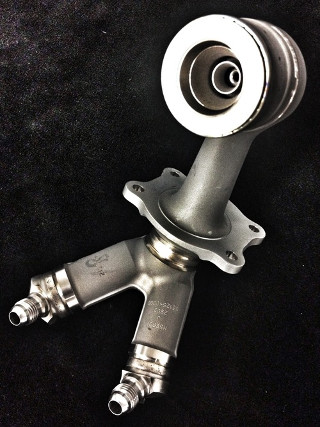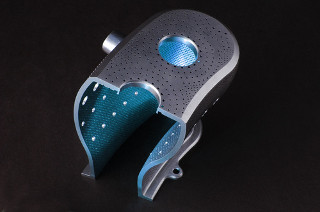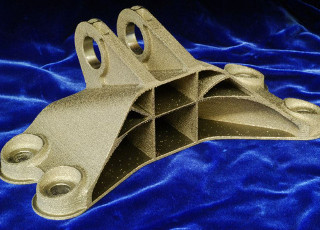 |
| August 25, 2015 | Volume 11 Issue 32 |
Designfax weekly eMagazine
Archives
Partners
Manufacturing Center
Product Spotlight
Modern Applications News
Metalworking Ideas For
Today's Job Shops
Tooling and Production
Strategies for large
metalworking plants
New GE research center aims to take 3D printing to a whole new level
By GE Reports
On Oct. 6, 2014, a Boeing 747 modified for testing jet engines taxied along a concrete runway on the edge of the Mojave Desert and took off with a brand new engine strapped to its left wing. Although the engine's maiden flight was short, it made aviation history.
For the first time, the GE engine, called LEAP, flew with 19 fuel nozzles 3D printed by a computer-guided laser from layers of metal powder. "We designed these nozzles to efficiently feed fuel into the jet engine, but they are also a work of art," says Greg Morris, a 3D-printing pioneer who leads additive manufacturing research at GE Aviation. (GE Aviation acquired his company, Morris Technologies, in 2012.) "Methods like 3D printing give designers new freedoms and unleash their imagination. You couldn't make this nozzle any other way."

A 3D-printed fuel nozzle for the LEAP jet engine. [Image credit: CFM International]
GE is aiming to have 3D printing and other additive manufacturing tools like it liberate every designer on its payroll. The company is spending $32 million building a new research and education center focused on additive technologies in Pennsylvania. "We want to light the fire behind additive," Morris says. "This is still a young tool, but it's also a very powerful and disruptive tool. We want to maximize its use across all of GE's businesses."
The new center is scheduled to open by the end of 2015.
Additive manufacturing is the opposite of traditional "subtractive" manufacturing methods like turning, milling, and drilling, which remove material from the product to achieve its final shape. Additive techniques, as the name implies, make parts by adding one thin layer of material on top of another. It's like building a loaf of bread from individual slices.
This approach allows designers to achieve lighter and more durable shapes that were previously impossible to produce. Since the finished components are very close to the final look, the technology can also dramatically reduce manufacturing waste.

Additive manufacturing allows designers to create parts like this jet engine combustor that would be very difficult to make on conventional machines. [Image credit: GE Aviation]
The 3D-printed LEAP fuel nozzle, for example, is five times more durable than the previous model and 25 percent lighter. Additive manufacturing allowed engineers to reduce the number of individual pieces that were brazed and welded together from 20 to just one part, and achieve the best fuel flow geometry. "These tools unleash incredible creativity," Morris says.
(The nozzles are made by Advanced Atomization Technologies, a joint venture between GE and Parker Aerospace. The LEAP engine was developed by CFM International, a joint company owned equally by GE and France's Snecma.)
GE will use the new 125,000-sq-ft facility, which will be located in western Pennsylvania, to train designers and engineers on additive manufacturing design and production, and work closely with students at nearby Carnegie Mellon University, Penn State, and the University of Pittsburgh.

Last year, GE and GrabCAD held an open 3D-printing challenge to redesign a jet engine bracket. The original bracket weighed 2,033 g (4.48 lb), but the winner was able to reduce its weight by nearly 84 percent to just 327 g (0.72 lb).
The center will have 3D printers and other additive machines that can work both with plastics and metal. GE businesses will have access to the machines to handle overflow orders, make prototypes, and produce new parts without spending capital on their own. "The idea is to bring everyone together, share costs, and explore our common needs," Morris says. "It will also help us keep certain intellectual property in-house."
Besides using additive manufacturing to make things, the center's 50 engineers will also work on developing new materials for additive technologies.
The new center will join five advanced manufacturing businesses that GE opened in the U.S. in the last three years: Greenville, SC (Power & Water), Asheville, NC (Aviation), Auburn, AL (Aviation), Jacksonville, FL (Oil & Gas), and Rutland, VT (Aviation).
Dan Heintzelman, GE vice chairman, said that a recent $75 million upgrade of the Rutland center has allowed GE Aviation to apply new advanced manufacturing technology to jet engine production and save $300 million.
"We made a big bet that additive manufacturing is not a flash in a pan," Morris says. "We know this is a way we are going to make various parts in the future. We are now in the process of training people and building awareness throughout the company. Engineers need to realize that they have this very powerful and enabling tool at their disposal."
Read more GE Reports at www.gereports.com.
Published September 2015
Rate this article
View our terms of use and privacy policy
